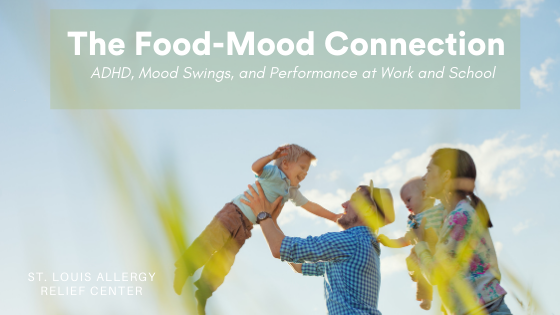The Food-Mood Connection, ADHD, Mood Swings, and Performance at Work and School

The Food-Mood Connection
ADHD, Mood Swings, and Performance at Work and School
You already know that what you eat triggers your sense of taste. But did you know that what you eat also triggers your perceptions and emotions? The Food-Mood Connection, ADHD, Mood Swings, and Performance at Work and School Yet most of the time we don’t recognize the connection between what we are eating and how we are feeling. Think about your own experience. Have you ever felt fatigued after a meal? How about difficulty focusing after certain meals and yet energized after other meals? Have you ever felt irritable between meals? Food changes our mood. And our mood affects our relationships as well as our performance at work and school.
If you or your child are eating foods laced with artificial colors/flavors/preservatives, pesticide-laden foods, processed foods, fast food, or other junk foods, it’s hard to feel energized, inspired, content, and happy. Julia Ross, the author of The Mood Cure, calls this process the Law of Malnutrition.
The Law of Malnutrition describes the relationship between mood changes and the eating of processed or fried foods along with a lack of fresh vegetables and non-flavored water. That pretty much describes the bulk of the American diet for most children and working adults.
Dr. Ross claims that the epidemic of bad moods (including ADHD, emotional swings, anxiety, and depression) in America is linked to the epidemic of deteriorating food quality. She states, “Junk moods come from junk foods”.
The nutrition label on packaged foods shows the percent of its various nutrients for a 2000 to 2200 calorie a day diet. Let’s put this into perspective. Here are two choices you have when consuming 2200 calories in a day:
First choice: you could eat one package of Oreo Cookies which, by the way, has 2200 calories. On the one hand, those Oreo’s may sound pretty yummy. On the other hand, that’s your entire daily caloric intake and that’s without milk to wash down those yummy cookies!
Second choice: to consume those same 2200 calories you could eat 1 pound of carrots, 1 pound of papaya, 1 pound of apples, 1 pound of onions, 1 pound of lettuce, 1 pound of kale, 2 pounds of broccoli, 2 pounds of cantaloupe, 2 pounds of celery, 2 pounds of cucumber, and—last but not least—throw in 1 pound of chicken breast.
Of course, you couldn’t eat 15 pounds of food in one day. But the real question is, “Which daily caloric intake do you think will enhance your health and well-being?”
I would guess everyone probably already knew the answer to that question. But how many live it?
The standard American diet (aka, the SAD Diet) consists of soda, sweet beverages, chocolate, ice cream, potato chips, fries, chicken nuggets and hamburger patties made from who knows what. And these are the same foods many people turn to when they are in a bad mood. Ironically, these are also the foods that contribute to our mood swings in the first place.
Have you ever wondered how often we blame other people for making us irritable—when it’s really our own emotional state that causes us to be irritable with them?
The balance between the foods we eat and the moods we feel varies individually. Some people are more sensitive to certain foods than others. Only you can determine the right amount of sugar, protein, carbs, and fats that keep you balanced, healthy, and happy.
The best way to learn what’s right for you is to keep a journal of everything you (or your child) eat and how you feel after you’ve eaten. You will discover what foods trigger good or bad mood changes immediately. And, if you diligently keep the journal of how you feel by the time of day, you’ll also learn what foods take more time to affect your moods. It would be an interesting experiment for you to try.
By the way, many people reading this are probably taking medication or nutritional supplements to help with mood swings. But did you also know that food allergies and food sensitivities can contribute more to mood swings than the chemistry of the food itself?
That’s where St. Louis Allergy Relief Center comes in. Many of you already know our treatments help with seasonal and food allergies. But now you know how our treatments may also help you emotionally.
Additionally, all children (and adults) diagnosed with ADD or ADHD have food allergies or sensitivities. And once we treat them, most find it easier to balance their emotional ups and downs.
Of course, there is no one-size-fits-all solution to any human problem.
It’s all about trying to eat and live healthy in a world that constantly markets and promotes the unhealthy. And if you read this far in the article, you probably already knew that.
Ian Wahl is the founder and clinical director of St. Louis Allergy Relief Center, a holistic allergy and asthma clinic in Chesterfield, MO. For more information see www.StLouisAllergyRelief.com or call 314-384-9304 to learn how their all-natural treatments help relieve seasonal and chronic sinus, skin, stimuli, and food allergies.
Sources:
Ross, Julia, The Diet Cure: The 8 Step Program to Rebalance Your Body Chemistry and End Food Cravings, Weight Gain, and Mood Swings Naturally
Ross, Julia, The Mood Cure: The 4 Step Program to Take Charge of Your Emotions